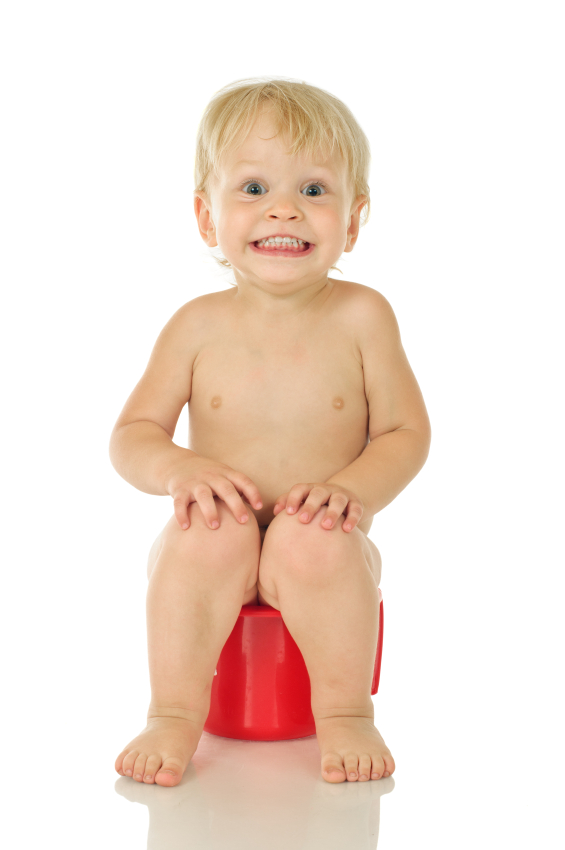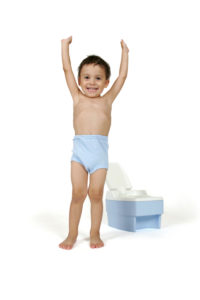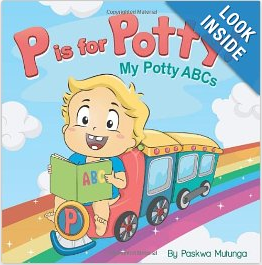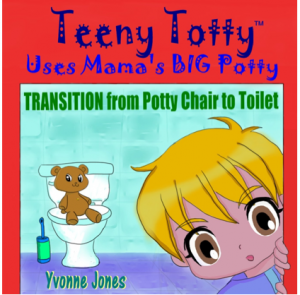By Colleen Brunetti, M.Ed., C.H.C.
There are endless ways to go about potty training. From diaperless babies, to waiting for signs of readiness, to pull-ups or underwear or commando… parents actually have a lot of decisions to make when embarking on potty training!
One method that is popular with some parents is a “potty training boot camp” – in short, these programs (which you often purchase) promise that with a determined attitude, solid plan, hard work, and an intense few days, you can have a fully potty trained toddler, often in three days (or less!).
But does this method work? And is it best for kids?
The answer, much like the choices described above, completely depends on the kiddo and the family! Remembering that each child and family is different, and that Potty Time does not endorse a particular method, read on to learn some first hand stories from families who tried, succeeded, or moved on to something different.
IT WORKED FOR US!
Heather is the mom of two-year-old twin boys, Callum and Cole. She learned about a boot camp method from a friend. With the cost of diapers being high, and concern that potty training could take what seemed like years for some people, she was ready to give it a try when the boys were 25 months old. Most of all, she looked forward to no more poopy diapers, and “one more thing off my plate”.
It started out very positive. Supplies were ready, Mom and Dad were both home, and it was time to go! Callum got the boot camp method within an hour! For him, it was a complete success.
Cole, on the other hand, took a different path (as children often do!). It was more frustrating with him, with frequent accidents and a period of time where he just didn’t seem to be getting it. At first, Heather felt really bad about it, like she might be pushing him too hard and he just wasn’t ready. However, on the sixth hour of the third day, something clicked! Cole too had mastered potty training, and Heather says she got a reminder of what faith in your kids’ ability can be.
Heather recommends parents who want to try the potty training boot camp method stay strong and positive. She says you need to be 100% committed to the process, and has personally observed that people who try the method and stray too much had much less success.
IT SORT OF WORKED, BUT….
Jenna is the mom of three-year-old Ryan. With preschool looming in the coming months, and a new baby brother in the house, it was time to seriously commence potty training. Jenna looked forward to jumping right in, rather than taking a slower months-long method and Ryan was very excited to be the big brother and big boy in the house, and showed all signs of readiness. With friends on hand who had had previous success, and her husband home for three days with her, they began.
The potty training boot camp started out very positive, but it also soon became incredibly challenging. Ryan would miss the bathroom by seconds, and one day had nearly 20 accidents. Carpets, couches, and even a favorite toy, took a hit, and it became too stressful and discouraging for both child and parents.
Jenna said she found the program too rigid for her boy, for whom the boundaries were just “too tight”. She began to make tweaks to the program, choosing vocabulary that worked for Ryan and things that he would better respond to.
After about five days (instead of the three in the program), Ryan had made great strides and was successfully potty trained.
Jenna says the potty training boot camp she chose had great advice, but you have to make these programs work for your child. She recommends not doing it alone, but have a partner or friend home with you too. Tag teaming becomes very helpful. Further, she felt age definitely made a difference for her son. Although at age two Ryan could sign “potty” and showed some signs of readiness, it seems it was the extra year of maturity that made potty training a success for him at age three.
IT DID NOT WORK FOR US!
Misty is mom to Hobie, now age three. Misty has tried the boot camp type approach twice. The first was when Hobie was about age two and a half. While Hobie was going naked from the waist down, and could understand the concept of going potty, the boot camp method was a huge struggle for him. Misty could tell he just wasn’t ready and did not continue past Day 2.
The second time she tried the method he was just over age three. At this point Hobie would sit on the potty, but he had very frequent accidents. This time Misty tried for a full week (programs generally promise about three days), and again felt it wasn’t right for him. She returned him to diapers.
But just a few days later, Hobie announced he didn’t want any more diapers. After he agreed to stay clean and dry, it was pretty much smooth sailing. As Misty says, “I guess it had to be his idea…note to self for the future.“
IN CONCLUSION
As you can see from these stories, a potty training method can be a flying success for one kid and an epic crash for another. It truly depends on the family dynamic, readiness of the child, and philosophy of the parent. The good news, as always, is they all eventually get it somehow at some time! So choose the method that you know works best for you, and carry on!

 The Instructors at the
The Instructors at the 




 By
By 
